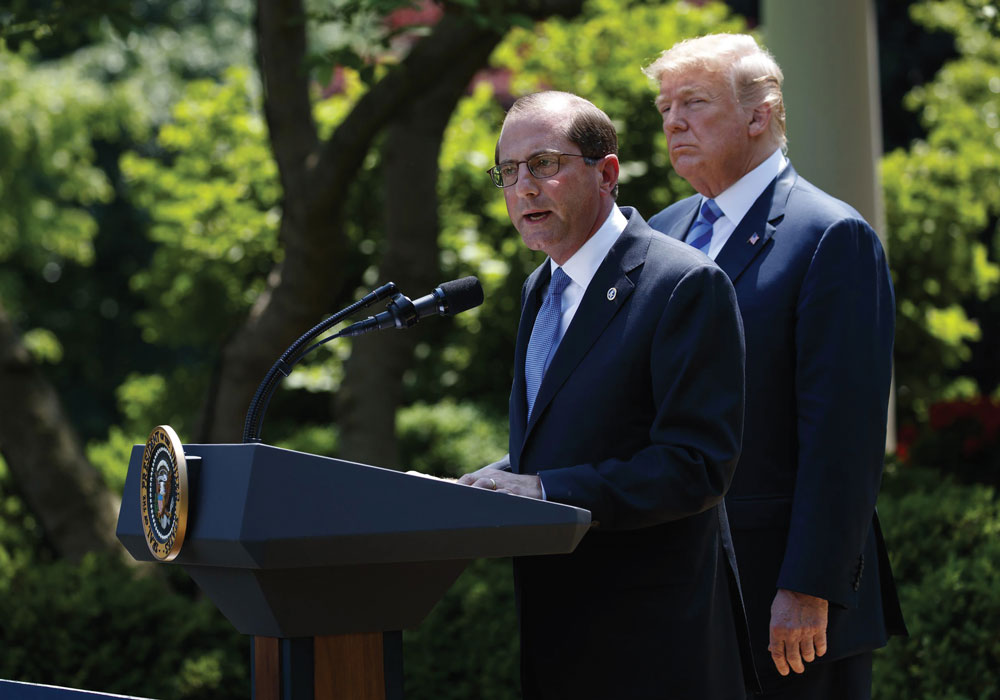At some point, almost all Americans have been stuck with massive, unexpected medical bills or forced to make health decisions without real information or anyone to guide them. We have worked at the highest levels of U.S. health care for years, yet it has happened to both of us.
Few know the power that prescription medications have on the quality of life for patients more than nurses. In more than just physical ways, access to affordable drugs is essential to patient-centered care and emotional, psychological, familial, and even financial stability. For too long, the cost and availability of medicines have been barriers to health care, rather than opportunities for survivorship.
In May 2018, President Trump issued several public statements drawing a line in the sand and vowing to bring a new level of transparency to how Americans receive and pay for their life-saving medications. Through the Department of Health and Human Services (HHS), the administration has issued a number of executive orders and regulatory proposals to disrupt the system, lower costs, and increase medical supplies. Yet both protecting patients and providing quality care is still an elusive process.
Rose Garden Announcement on Drug Pricing
In his May 2018 announcement, President Trump reminded the audience that he campaigned on changing the healthcare system, helping people to have more access to affordable drugs.
“My administration has already taken significant steps to get drug prices under control. We reformed the Drug Discount Program for safety net hospitals to save senior citizens hundreds of millions of dollars on drugs this year alone. We’re also increasing competition and reducing regulatory burdens so drugs can get to the market quicker and cheaper. We’re very much eliminating the middlemen,” President Trump said.
The president’s charge was to have HHS lower drug costs, reform Medicare Part D programs to incentivize the industry to provide affordable medications, and review the drug reimportation process, matching what the United States is paying to the fees in other countries for the same drugs.
Congressional Hearings and Testimony
In February 2019, the U.S. Senate Finance Committee grilled seven chief executives from the pharmaceutical industry on their practices, procedures, and profits. Chair Chuck Grassley (R-IA) and Ranking Member Ron Wyden (D-OR) aligned their support for innovation and investment, as well as their recognition that too many patients find alternative ways to take their medications.
In his opening comments, Wyden concluded with harsh words for the executives, saying, “It is long past time to drop the excuses and take concrete action to make medicine in America more affordable."
HHS’s New Policies for Transparency
More recently, President Trump issued a June 2019 executive order on improving price and quality transparency in American health care to put patients first. “For decades, powerful insurance companies, lobbyists, and special interests have denied the public access to the real cost of the healthcare services they provide. It’s that simple. This lack of price transparency has enriched industry giants greatly, costing Americans hundreds of billions of dollars a year,” President Trump said. The thought is that forcing drug companies to list patient costs in advertising would indirectly motivate companies to lower their prices.
Constitutionality Per U.S. Courts
Not surprisingly, several companies sued the federal government to prevent this from taking effect. In July 2019, the DC court ruled in favor of the plaintiffs—the pharmaceutical industry—that HHS had overstepped its regulatory authority in making such a mandate.
“Federal agencies typically enjoy expansive authority from Congress to formulate rules that have the force of law in areas germane to the statutes that they implement. But such authority is not unbounded. For a regulation to have the force of law, Congress must communicate through legislation, either expressly or impliedly, its intent for the agency to make rules in that specific area. When Congress has not communicated such intent, the agency has no power to act,” Judge Amit Mehta wrote. It was a setback for public awareness campaigns for transparency.
Drug Rebate Programs
In July 2019, the Trump administration pulled a price-reduction strategy it had proposed in the 2018 drug pricing blueprint. The rule, which had been controversial, would have eliminated drug rebates—which account for 26%–30% of a drug’s list price—to lower prescription drug prices and out-of-pocket costs by encouraging manufacturers to pass discounts directly on to patients at the point of sale. It had been one of the only rules that drug companies supported in the drug pricing conversation.
ONS Perspective and Patient-Centered Proposals
“Out-of-pocket expenses related to cancer treatment are like a physical toxicity in that they can decrease health-related quality of life (HRQOL) and impede delivery of the highest quality care. This financial burden has been linked with several clinically relevant patient outcomes, including decreased HRQOL, increased symptom burden, decreased compliance, and decreased survival.”
According to the National Cancer Institute, the “estimated national expenditures for cancer care in the United States in 2017 were $147.3 billion. In future years, costs are likely to increase as the population ages and cancer prevalence increases. Costs are also likely to increase as new, and often more expensive, treatments are adopted as standards of care.”
How can you help ONS’s advocacy efforts? Apply to represent your ONS chapter at Hill Days on September 22–24, 2019, or learn about the other ways to share your perspectives with policymakers.






